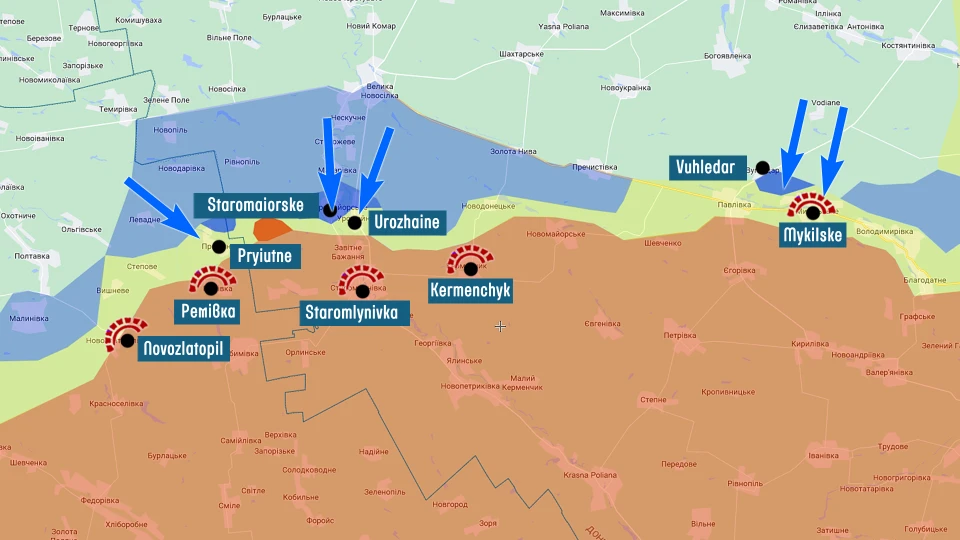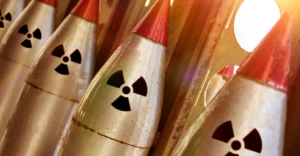
Russia tries to ease pressure from Ukraine’s army around Bakhmut and in south. Column by Serhiy Zgurets
Russia seeks redeployment of Ukrainian Armed Forces in the east and easing of pressure from Ukraine in the south and near Bakhmut
The situation around Kupyansk
Today, the mandatory evacuation of 37 settlements in Kupyansk district of Kharkiv region begins, as the Russian troops are terrorizing the locals, significantly increasing the shelling of frontline towns and villages. Threats to people's lives and health are growing, as the head of the Regional Military Administration Oleh Synyehubov said the day before. About 11 thousand residents, including 600 children, are to be evacuated. Russian troops are approximately 10 kilometers from Kupyansk. In September, Ukraine recaptured these areas and crossed Oskil, a key point in Kharkiv's lightning counteroffensive. The Russian Federation is trying to replay this moment and break through the Ukrainian defense and reach Kupyansk.
In the Kupyansk-Kreminna area, according to Ukrainian spokespersons, it has concentrated about 100,000 personnel and 900 tanks. Army Commander Oleksandr Syrskyi said that the Russian troops have created several Storm-Z assault units focused on taking Kupyansk, although the Ukrainian Armed Forces have redeployed and reinforced this area with artillery, so I think Russia's attempts will be in vain. However, the most important thing is that they are trying to get Ukrainian army to redistribute forces on the Kupyansk and Lyman directions, to move troops here, easing the pressure on the enemy, in particular, around Bakhmut and on the southern front, the deterrence of which is a super-task for the Russian enemy and where it is under significant pressure from Ukrainian side.
Southern direction
In the south, fighting continues for Staromayorske, Urozhaine, and Pryiutne.

Here, the front line does not change. But Russia is trying to hold Pryiutne, which is located on a hill. There are a number of water obstacles in front of it. The Russian adversary is holding there quite strongly. Near Urozhaine, they crossed the Mokry Yaly River. I think in some time the Russian Federation will be driven out of Urozhaine, which is important for Ukraine. The second area is the Zaporizhzhia section, the Ukrainian Armed Forces' advance towards Robotyne and Verbove. It is about overcoming Russia's first line of defense. Ukraine's Ministry of Defense reported partial success in the direction of Verbove. And Russia's guard recognizes the changes in this area. In particular, Z-military wrote that the assault units of the 46th Naval Brigade, with the support of the National Guard, attacked Russian positions east of Robotyne.
The sappers of the two brigades cleared minefields and went to break through Russia's defense 400 meters between the two forces. The task was accomplished and, with the support of artillery, the Defense Forces gained a foothold 3 km east of Robotyne. The Russian troops are now regrouping, although some of their troops have withdrawn. I think they will counterattack. In any area where we destroy the Russian invaders, they use aviation and artillery, trying to push Ukrainian units back. This methodology is used in almost every section of the southern front.
Konstiantyn Denysov, a fighter with the Legion of Freedom, said that the situation is dynamic, it is a challenge. The sappers are the busiest. They do a very large part of the work and at the same time are scouts, assault aircraft and infantrymen, paving the way, because after the Russian troops are driven out of the positions, they need to be cleared and we need to gain a foothold. The enemy leaves a lot of dangerous "gifts". If their first line (i.e., infantry, mobilized soldiers) falls through, they cover the gray zone with artillery. Russian aviation is working hard. The enemy has an advantage, conducting constant strikes from aircraft and helicopters, destroying civilian infrastructure on the front line.
There are positions that the Russian troops are forced to abandon under pressure from the Ukraine's Defense Forces, but it comes at a very high price for Ukraine.
They are not idiots on the enemy's side; they analyze the situation, our actions, and take certain measures. They have reinforcements, and fake volunteers are constantly bringing them logistical support, given the consequences of the fighting.
Ukraine has to change its tactics and show ingenuity to push back the Russian troops, because they are experienced and competent. Sometimes their engineering units seem to take incomprehensible steps, but in fact they have calculated everything and are trying to trap Ukrainian advanced units. However, the Defense Forces have also gained experience, learned and do not allow themselves to be fooled. The invaders are afraid of Western weapons in Ukraine, because they work well in the hands of Ukrainian soldiers.
There have been examples of such use that the developers were probably unaware of. When newly mobilized Russians enter, one of their main tasks is active mining. With active mining, superiority in artillery and aviation of the Russian Federation, our troops are slowly pushing the enemy out. They do not understand this. The invaders complain about the leadership on certain issues, but it's no big deal. Most of all, they do not understand Ukraine's motivation to move forward. Cluster munitions destroy Russian equipment and work on their positions. Any Western equipment and artillery is very much needed, because they allow Ukraine to destroy, in particular, Russian heavy artillery, because there are many units with it: artillery regiments and brigades. There are also missile units. Western artillery also provides very good support during the advance and attack on Russian positions.
Other weapons are useful during the advance because they save the lives of Ukrainian soldiers. There is a shortage of it because the losses of equipment are high. The Russian troops mine the territory, use FPV drones, and employ various tactics, having worked out quickly and hiding. Sometimes it is impossible to strike back quickly. These are probably the main factors that lead to the loss of Ukraine's equipment.
The work of the AFU snipers near Bakhmut
The Bakhmut direction remains an active combat zone. At least 100 thousand enemies were destroyed there. Between 20 and 40 thousand were killed. Bakhmut continues to be held by a significant number of Russians - up to 50,000 Ukrainian Armed Forces are advancing on the southern flank. Over the past two days, Russia has been deploying new units to hold the southern and northern flanks. Ukrainian soldiers are not entering the city itself, although the special forces are operating in certain areas. Ukrainian snipers are working quite effectively, destroying the Russian enemy near Bakhmut.
The deputy commander of the Hrim special forces unit, known by his call sign Did (Grandfather, old man - ukr.), said that snipers are performing their missions in different ways. Ukrainian and Russian snipers are working in the north-east. We have a level of training sufficient to work at a distance of 1.5-1.8 km. The Ukrainian Armed Forces can practice. When they get closer to Bakhmut, Russian sniper groups work from bombed-out high-rise buildings, in particular, on infantry storming enemy positions. Today, sniper groups - special operations forces, snipers from the 57th and 66th brigades - are working quite effectively at normal distances to eliminate all targets, because they need to destroy everything they see. Aerial reconnaissance, infantry, and assault groups are working, entering positions, destroying the enemy and helping snipers.
The main task is not only anti-sniper work, but also support, in particular, for assault groups, when we can enter positions and work on the assaulters' advance.
Now they are working in threes with different calibers. The 50-caliber Barrett rifle, which can easily and quickly break a small fortified area, is starting to work. Then came the 338th and 308th caliber, and so on. There is a clear understanding of who and how works in different positions, so that the assault groups can pass through without losses.
Later on, the cover starts to be used on the points where Russian snipers could theoretically be. Where it is impossible to reach, artillery is sent in so that snipers can approach and cover the stormtroopers, get to a working distance, and work to move even further. Now the distance to the firing point is 7-8 kilometers.
Snipers carry 23-25 kg, as well as body armor, food, water, ammunition for other weapons at +35 °C. The trails are being shot at, but there are no options because the Ukrainian military are waiting for support. At the beginning of the full-scale war, the unit was given a Sherp. Did says it's the most necessary thing, despite its many disadvantages. It is sometimes too noisy, but it goes where neither an APC nor a tank can go.
The offroad vehicle helped to cross the Siverskyi Donets River over a year ago. Certain groups went in and worked out. The groups had some losses, mostly wounded. They also needed food, water and medical supplies. The offroad vehicle crossed, delivered food, and took the wounded. It was a long walk to the evacuation point, but it was possible. The Sherp proved to be the best of its kind. Offroad vehicles are needed by units. They need to be strategically and tactically prepared for use, but this vehicle can deliver everything they need to places where no one else can.
- News














































